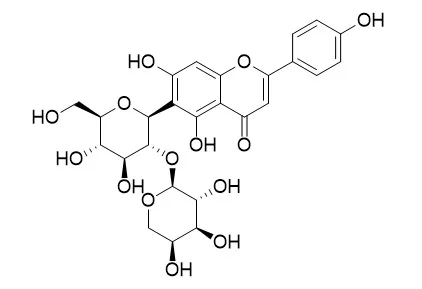| In vitro: |
| Journal of Plant Physiology, 1988, 133(2):178-182. | | Biochemical and Immunological Characterization of Chalcone Synthase from Rye Leaves.[Reference: WebLink] | As part of investigations on the role and the location of the key enzyme of flavonoid biosynthesis, chalcone synthase (CHS) in leaf tissues of Gramineae, CHS from rye (Secale cereale L.) was purified and characterized biochemically and immunologically.
METHODS AND RESULTS:
Km-values for the substrates p-coumaroyl-CoA and caffeoyl-CoA were 0.6 and 1.45 μM, respectively, the corresponding Km-values for malonyl-CoA were 1.4 and 1.5 μM. The pH-optimum for the formation of 2′,4,4′,6′-tetrahydroxychalcone was 8 and for the formation of 2′,3,4,4′,6′-pentahydroxychalcone, 6.5. A 50% reduction in enzyme activity was caused by 9 μM apigenin, 13 μM luteolin, 36 μM CoA, 45 μM naringenin, 45 μM eriodictyol, and 62 μM Isovitexin 2''-O-arabinoside. SDS-PAGE analysis of the purified enzyme revealed two peptides with apparent molecular weights of 43 and 44 kd, respectively.
CONCLUSIONS:
On western blots run with the purified enzyme as well as with crude enzyme extracts, both peptides were immunostained by polyclonal antibodies raised against rye or parsley CHS. The recognition of these peptides by single monoclonal antibodies demonstrated that both peptides were similar and derived from CHS. Applied to western blots run with CHS-containing extracts of parsley, spinach, pea, maize, and oat, the same antibodies labelled only a single peptide, or in some cases probably even more than two peptides. |
|






 Cell. 2018 Jan 11;172(1-2):249-261.e12. doi: 10.1016/j.cell.2017.12.019.IF=36.216(2019)
Cell. 2018 Jan 11;172(1-2):249-261.e12. doi: 10.1016/j.cell.2017.12.019.IF=36.216(2019) Cell Metab. 2020 Mar 3;31(3):534-548.e5. doi: 10.1016/j.cmet.2020.01.002.IF=22.415(2019)
Cell Metab. 2020 Mar 3;31(3):534-548.e5. doi: 10.1016/j.cmet.2020.01.002.IF=22.415(2019) Mol Cell. 2017 Nov 16;68(4):673-685.e6. doi: 10.1016/j.molcel.2017.10.022.IF=14.548(2019)
Mol Cell. 2017 Nov 16;68(4):673-685.e6. doi: 10.1016/j.molcel.2017.10.022.IF=14.548(2019)